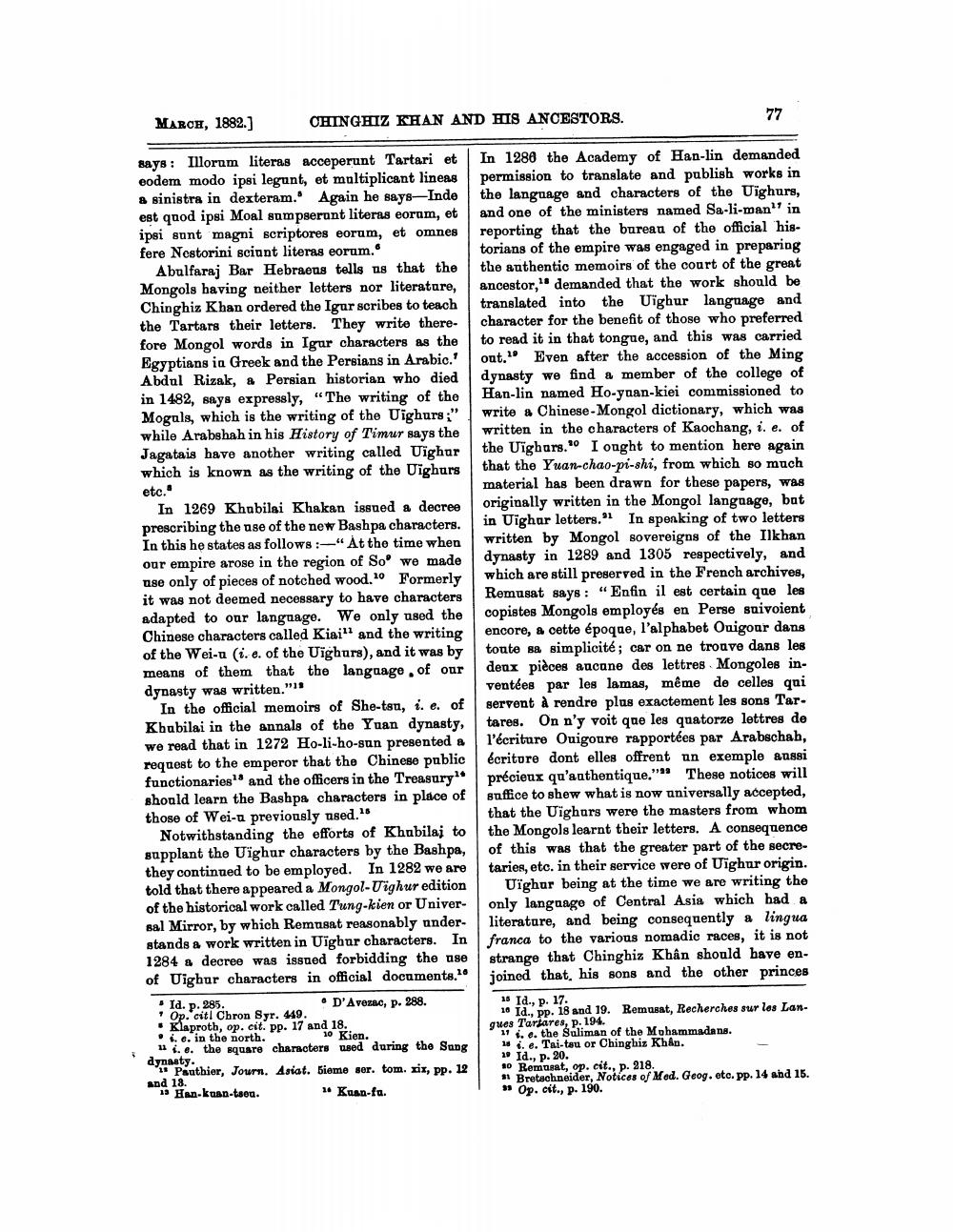________________
MARCH, 1882.]
says: Illorum literas acceperunt Tartari et eodem modo ipsi legunt, et multiplicant lineas a sinistra in dexteram. Again he says-Inde est quod ipsi Moal sumpserunt literas eorum, et ipsi sunt magni scriptores eorum, et omnes fere Nestorini sciunt literas eorum."
CHINGHIZ KHAN AND HIS ANCESTORS.
Abulfaraj Bar Hebraens tells us that the Mongols having neither letters nor literature, Chinghiz Khan ordered the Igur scribes to teach the Tartars their letters. They write therefore Mongol words in Igur characters as the Egyptians in Greek and the Persians in Arabic.' Abdul Rizak, a Persian historian who died in 1482, says expressly, "The writing of the Moguls, which is the writing of the Uighurs;" while Arabshah in his History of Timur says the Jagatais have another writing called Uighur which is known as the writing of the Uighurs etc."
In 1269 Khubilai Khakan issued a decree prescribing the use of the new Bashpa characters. In this he states as follows:-"At the time when our empire arose in the region of So we made use only of pieces of notched wood. 10 Formerly it was not deemed necessary to have characters adapted to our language. We only used the Chinese characters called Kiai" and the writing of the Wei-u (i. e. of the Uighurs), and it was by means of them that the language, of our dynasty was written."1"
In the official memoirs of She-tsu, i. e. of Khubilai in the annals of the Yuan dynasty, we read that in 1272 Ho-li-ho-sun presented a request to the emperor that the Chinese public functionaries and the officers in the Treasury should learn the Bashpa characters in place of those of Wei-u previously used.15
Notwithstanding the efforts of Khubilaj to supplant the Uighur characters by the Bashpa, they continued to be employed. In 1282 we are told that there appeared a Mongol-Uighur edition of the historical work called Tung-kien or Universal Mirror, by which Remusat reasonably understands a work written in Uighur characters. In 1284 a decree was issued forbidding the use of Uighur characters in official documents.10
D'Avezac, p. 288.
Id. p. 285. Op. cit! Chron Syr. 449. Klaproth, op. cit. pp. 17 and 18. i. e. in the north. 11. e. the square characters used during the Sung dynasty.
10 Kien.
Pauthier, Journ. Asiat. 5ieme ser. tom. xix, pp. 12
10 Kuan-fu.
and 13.
13 Han-kuan-tsen.
77
18
In 1288 the Academy of Han-lin demanded permission to translate and publish works in the language and characters of the Uighurs, and one of the ministers named Sa-li-man' in reporting that the bureau of the official historians of the empire was engaged in preparing the authentic memoirs of the court of the great ancestor, demanded that the work should be translated into the Uighur language and character for the benefit of those who preferred to read it in that tongue, and this was carried out. Even after the accession of the Ming dynasty we find a member of the college of Han-lin named Ho-ynan-kiei commissioned to write a Chinese-Mongol dictionary, which was written in the characters of Kaochang, i. e. of the Uighurs. I ought to mention here again that the Yuan-chao-pi-shi, from which so much material has been drawn for these papers, was originally written in the Mongol language, but in Uighur letters." In speaking of two letters written by Mongol sovereigns of the Ilkhan dynasty in 1289 and 1305 respectively, and which are still preserved in the French archives, Remusat says: "Enfin il est certain que les copistes Mongols employés en Perse suivoient encore, a cette époque, l'alphabet Ouigour dans toute sa simplicité; car on ne trouve dans les deux pièces aucune des lettres Mongoles inventées par les lamas, même de celles qui servent à rendre plus exactement les sons Tartares. On n'y voit que les quatorze lettres de l'écriture Ouigoure rapportées par Arabschah, écriture dont elles offrent un exemple anssi "These notices will précieux qu'authentique."" suffice to shew what is now universally accepted, that the Uighurs were the masters from whom the Mongols learnt their letters. A consequence of this was that the greater part of the secretaries, etc. in their service were of Uighur origin.
Uighur being at the time we are writing the only language of Central Asia which had a literature, and being consequently a lingua franca to the various nomadic races, it is not strange that Chinghiz Khân should have enjoined that, his sons and the other princes
15 Id., p.
17.
16 Id., pp. 18 and 19. Remusat, Recherches sur les Langues Tartares, p. 194.
17. e. the Suliman of the Muhammadans.
18. e. Tai-tsu or Chinghiz Khân.
19 Id., p. 20.
so Remusat, op. cit., p. 218.
31 Bretschneider, Notices of Med. Geog. etc. pp. 14 and 15. ss Op. cit., p. 190.




